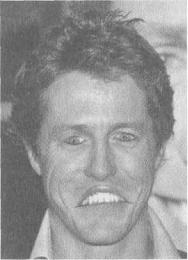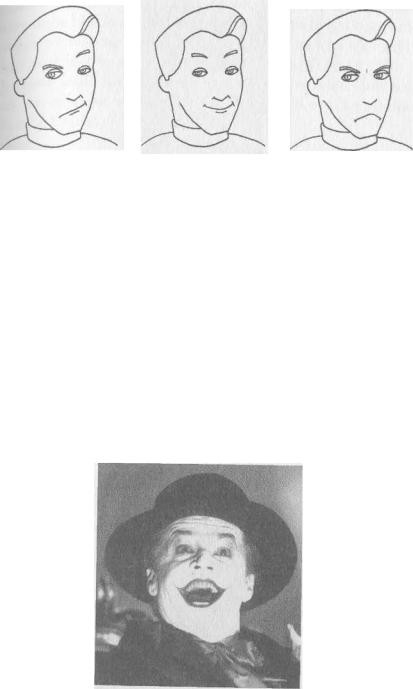
Books on Happiness / The Definitive Book Of Body Language- 2 students
.pdf
The Magic of Smiles and Laughter
We cut and pasted Grant's eyes and smile to produce a hor- rific-looking face but, as you can see, your brain can even identify a smile when a face is upside down. Not only can it do that, but the brain can separate the smile from every other part of the face. This illustrates the powerful effect a smile has on
us.
Practising the Fake Smile
As we've said, most people can't consciously differentiate between a fake smile and a real one, and most of us are content if someone is simply smiling at us — regardless of whether it's real or false. Because smiling is such a disarming gesture, most people wrongly assume that it's a favourite of liars. Research by Paul Ekman showed that when people deliberately lie, most, especially men, smile less than they usually do. Ekman believes this is because liars realise that most
peopleassociate smiling with lying so they intentionally decrease their smiles. A liar's smile comes more quickly than a genuine smile and is held much longer, almost as if the liar is wearing a mask.
A false smile often appears stronger on one side of the face
73

The Definitive Book of Body Language
than the other, as both sides of the brain attempt to make it appear genuine. The half of the brain's cortex that specialises in facial expressions is in the right hemisphere and sends signals mainly to the left side of the body. As a result, false facial emotions are more pronounced on the left side of the face than the right. In a real smile, both brain hemispheres instruct each side of the face to act with symmetry.
When liars lie, the left side of the smile is usually more pronounced than the right
Smugglers Smile Less
We were commissioned by Australian Customs, in 1986, to help create a programme to increase the number of seizures of illegal contraband and drugs being smuggled into AustraliaUntil that time, it had been assumed by law enforcement officers that liars increased their frequency of smiling when they were lying or under pressure. Our analysis of film of people who were intentionally told to lie showed the opposite - when the liars lied, they smiled less or not at all, regardless of culture. People who were innocent and telling the truth increased their smiling frequency when being honest. Because smiling is rooted in submission, the innocent people were attempting to appease their accusers while the professional liars were reducing their smiles and other body signals. It's the
7 4

The Magic of Smiles and Laughter
same as when a police car pulls up next to you at traffic lights -even though you haven't broken the law, the presence of the police is enough to make you feel guilty and start smiling. This highlights how fake smiling is controlled and should always be considered in the context of where it occurs.
Five Common Types of Smiles
What follows is a summary and an analysis of the common types of smiles that you're likely to see every day:
1.TheTight-Lipped Smile
The lips are stretched tight across the face to form a straight line and the teeth are concealed. It sends the message that the smiler has a secret or a withheld opinion or attitude that they will not be sharing with you. It's a favourite of women who don't want to reveal that they don't like someone and is usually clearly read by other women as a rejection signal. Most men are oblivious to it.
The Tight-Lipped Smile shows she has a secret and won't be sharing it with you
for example, one woman might say of another woman, 'She's a very capable woman who knows what she wants', followed by a tight-lipped smile, rather than saying what she was really
75

The Definitive Book of Body Language
thinking: 'I think she's an aggressive, pushy bitch!' The TightLipped Smile is also seen in magazine pictures of successful businessmen who are communicating 'I've got the secrets of success and you've got to try and guess what they are.' In these interviews, the men have a tendency to talk about principles of success but rarely do they reveal the exact details of how they succeeded. Conversely, Richard Branson is always seen sporting a wide toothy smile and is happy to explain the exact details of his success because he knows that most people won't do it anyway.
Tony and Cherie Blair were 'tight lipped' about Cherie's last pregnancy
2.The Twisted Smile
This smile shows opposite emotions on each side of the face. In picture A below, the right brain raises the left side eyebrow, the left zygomatic muscles and left cheek to produce one type of smile on the left side of the face while the left brain pulls the same muscles downwards on the right side to produce an angry frown. When you place a mirror down the middle of illustration A, at an angle of 90 degrees to reflect each side of the face, you produce two completely different faces with opposite emotions. Mirroring the right side of the face reveals picture B, which has a cheesy grin, while mirroring the left side (picture C) reveals an angry frown.
76

The Magic of Smiles and Laughter
A B C
The Twisted Smile is peculiar to the Western world and can only be done deliberately which means it can send only one message - sarcasm.
3.The Drop-Jaw Smile
This is a practised smile where the lower jaw is simply dropped down to give the impression that the person is laughing or playful. This is a favourite of people such as The Joker in Batman, Bill Clinton and Hugh Grant, all of whom use it to engender happy reactions in their audiences or to win more votes.
Drop-Jaw smile with an attempt to fake smiling eyes
77

The Definitive Book of Body Language
A Drop-Jaw smile where only the jaw is lowered to feign enjoyment
4. Sideways-Looking-Up Smile
With the head turned down and away while looking up with a Tight-Lipped Smile, the smiler looks juvenile, playful and secretive. This coy smile has been shown to be men's favourite everywhere, because when a woman does it, it engenders parental male feelings, making men want to protect and care for females. This is one of the smiles Princess Diana used to captivate the hearts of people everywhere.
Diana's Sideways-Looking-Up smile had a powerful effect on both men and women
78
The Magic of Smiles and Laughter
This smile made men want to protect her, and made women want to be like her. Not surprisingly, this smile is a regular in men's courtship repertoire for attracting men as it's read by as seductive and is a powerful 'come-on' signal. This is the same smile now used by Prince William, which not only
has the effect of winning people's affection, it also reminds them of Diana.
5.The George W Bush Grin
President George W Bush always has a permanent smirk on his face. Ray Birdwhistell found that smiling among middle-class people is most common in Atlanta, Louisville, Memphis, Nashville and most of Texas. Bush is a Texan and they smile more than most other Americans. As a result, in Texas, an unsmiling individual might be asked if he was 'angry about something', while in New York, the smiler might be asked, 'What's so funny?' President Jimmy Carter was also a Southerner who smiled all the time. This worried the Northerners who feared that he knew something they didn't.
Smile constantly. Everyone will wonder what you've been up to.
Why Laughter Is the Best Medicine
As with smiling, when laughter is incorporated as a permanent part of who you are, it attracts friends, improves health and extends life. When we laugh, every organ in the body is affected a positive way. Our breathing quickens, which exercises the diaphragm,neck, stomach, face and shoulders. Laughter creases the amount of oxygen in the blood, which not only helps healing and improves circulation, it also expands the blood vessels close to the skin's surface. This is why people go in the face when they laugh. It can also lower the heart rate, dilate the arteries, stimulate the appetite and burn up calories.
79
The Definitive Book of Body Language
Neurologist Henri Rubenstein found that one minute of solid laughter provides up to 45 minutes of subsequent relaxation. Professor William Fry at Stanford University reported that 100 laughs will give your body an aerobic workout equal to that of a ten-minute session on a rowing machine. Medically speaking, this is why a damn good laugh is damn good for you.
The older we become, the more serious we become about life. An adult laughs an average of 15 times a day; a preschooler laughs an average of 400 times.
Why You Should Take Laughter Seriously
Research shows that people who laugh or smile, even when they don't feel especially happy, make part of the 'happy zone' in the brain's left hemisphere surge with electrical activity. In one of his numerous studies on laughter, Richard Davidson, professor of psychology and psychiatry at the University of Wisconsin in Madison, hooked subjects up to EEG (electroencephalograph) machines, which measure brain wave activity, and showed them funny movies. Smiling made their happy zones click wildly. He proved that intentionally producing smiles and laughter moves brain activity towards spontaneous happiness.
Arnie Cann, professor of psychology at the University of North Carolina, discovered that humour has a positive impact in counteracting stress. Cann led an experiment with people who were showing early signs of depression. Two groups watched videos over a three-week period. The group that watched comedy videos showed more improvement in their symptoms than did a control group that watched non-humor- ous videos. He also found that people with ulcers frown more than people without ulcers. If you catch yourself frowning' practise putting your hand on your forehead when you talk, to train yourself out of it.
80
The Magic of Smiles and Laughter
Why We Laugh and Talk, But Chimps Don't
Robert Provine, professor of psychology at the University of Maryland, Baltimore, found that human laughter is different from that of our primate cousins. Chimpanzee laughter sounds like panting, with only one sound made per outward or inward breath. It's this one-to-one ratio between breath cycle and vocalisation that makes it impossible for most primates to speak. When humans began walking upright, it freed the upper body from weight-bearing functions and allowed better breath control. As a result, humans can chop an exhalation and modulate it to produce language and laughter. Chimps can have linguistic concepts, but they can't physically make the sounds of language. Because we walk upright, humans have a huge range of freedom in the sounds we make, including speech and laughter.
How Humour Heals
Laughter stimulates the body's natural painkillers and 'feel good' enhancers, known as endorphins, helping relieve stress and heal the body. When Norman Cousins was diagnosed with the debilitating illness ankylospondylitis, the doctors told him they could no longer help him and that he would live in excruciating pain before he died. Cousins checked into a hotel room and hired every funny movie he could find: the Marx Brothers,
Airplane and The Three Stooges, etc. He watched and rewatched them over and over, laughing as hard and loud as he could. After six months of this self-inflicted laughter therapy, thedoctors were amazed to find that his illness had been cometely cured - the disease was gone! This amazing outcome led to the publishing of Cousins' book, Anatomy of an Illness, and the start of massive research into the function of endorphins. Endorphins are chemicals released from the brain when you laugh. They have a similar chemical composition to morphine and heroin and have a tranquillising effect on the body,
81
The Definitive Book of Body Language
while building the immune system. This explains why happy people rarely get sick and miserable but complaining people often seem to be ill.
Laughing Till You Cry
Laughter and crying are closely linked from a psychological and physiological standpoint. Think of the last time someone told you a joke that made you buckle up with laughter and you could hardly control yourself. How did you feel afterwards? You felt a tingling sensation all over, right? Your brain released endorphins into your system that gave you what was once described as a 'natural high' and is the same experience that drug addicts get when they take dope. People who have trouble with laughing at the tough things in life often turn to drugs and alcohol to achieve the same feeling that endorphininduced laughter produces. Alcohol loosens inhibitions and lets people laugh more, which releases endorphins. This is why most well-adjusted people laugh more when they drink alcohol, while unhappy people become even more despondent or even violent.
People drink alcohol and take drugs to try to feel how happy people feel normally.
Paul Ekman found that one of the reasons we are attracted to smiling and laughing faces is because they can actually affect our autonomic nervous system. We smile when we see a smiling face and this releases endorphins into our system. If you are surrounded by miserable, unhappy people you are also likely to mirror their expressions and become morose or depressed.
82
